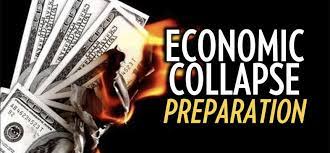This is the summary of another article on preparation in anticipation of the US dollar collapse, Dollar Collapse Preparation Plan, by Mr Jim Rickards. His free report can be found in https://dailyreckoning.com.
There are four scenarios that can usher in the collapse – inflation, deflation, market collapse and financial warfare.
Inflation
In the scenario of inflation, it is simply the value of your money is diminishing. Between 1977 to 1981, the US dollar lost half of its value in just five years. The losers will be those who hold dollar deposit, insurance, retirement income, pensions, annuities and savings. That is, any kind of fixed dollar amount is going to devalue in the event of inflation. Presently with so much printing of money by the Federal Reserve and yet there seems to be very little inflation. But it can come suddenly and we have to be ready for it.
Deflation
Deflation is the opposite of inflation. Money actually worth more while other asset classes lose value. But governments hate deflation because the value of their debts goes up. For people who borrow a lot from the bank to buy houses for example, and the value of the houses go down, they will be caught with margin call from the bank.
Market Collapse
We had seen three such collapses in 1998, 2001 and 2008. In 2008, people lost 50% of the value of their stocks and houses. And it came very quickly and almost out of nowhere. Contagion can happen very quickly. When the subprime loans were having problem, the US hedge funds were selling Japanese stocks to raise cash for margin call. That is the kind of contagion which cause other stock markets to suffer as well.
Financial Warfare
Inflation, deflation and market collapse have happened before. But financial warfare is new. The British ever blockaded France during the Napoleonic wars to cut off French access to imported goods and war materials. In the current environment, states can use stocks, bonds, commodities, derivatives and foreign exchange to fight other enemy states. Financial warfare can also include cyber-warfare to hack computer systems. Today, we are so digitized that if these computer systems running the economy are hacked, everything can be brought to a halt.
Sidestepping The Crisis
In 1920, the Weimar Republic of Germany was the best example of a major industrialized economy that faced hyperinflation in history. A load of bread, which used to cost one Reich mark, eventually cost 4 trillion marks. Outrageous, isn’t it ? One German guy, Hugo Stinnes, made a fortune instead and became the richest German then in 1922. He had the right assets in energy and transportation. If you have these hard assets such as factories, you don’t get wiped out. So how do we diversify ? We can start with 10 to 20% of our investment portfolio in gold. Gold is physical and not digital and cannot be wiped out unlike being in the digital accounts in banks. Gold is a very good insurance policy. Gold should be kept in independent storage places and not in banks in case banks get closed down. Keep some cash as part of the portfolio. It is a good deflation hedge. Gold and cash are hedges against inflation and deflation respectively. Cash can also give us opportunity to buy important assets at the right price. We can keep money in the bank up to the insured limit only. Investing in energy and transportation assets are great hedges against inflation.


